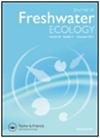白洋淀悬浮生态床对浮游植物群落结构的影响
IF 1.4
4区 环境科学与生态学
Q3 ECOLOGY
引用次数: 0
摘要
摘要针对白洋淀深水区淹没植被恢复问题,设计了一种由水生植物、绳索和支撑杆构成的悬空生态床。悬浮生态床的深度可以根据水位进行调整。2019年7 - 11月,对悬空床周围水体浮游植物群落结构进行了连续监测,研究悬空床中存在的沉水植物对湖泊深水区浮游植物群落结构的影响。结果表明:狐尾藻在悬浮床中生长良好,60 d后存活率达95%,55 d生物量达到最大值,水面覆盖度达到23%。悬浮生态床周围水域浮游植物共71种,分属7门。原绿藻超过一半(36种),浮游植物的平均密度和生物量呈逐月递减趋势。群落中蓝藻门的比例呈下降趋势,其他浮游植物门的比例呈上升趋势。年平均Shannon-Wiener多样性指数为0.88,年平均Pielou均匀度指数为0.32,年平均Margalef丰富度指数为1.21。Shannon-Wiener多样性指数和Pielou均匀度指数均呈上升趋势。综合分析表明,在悬浮床中种植沉水植物可以改善周围水体的浮游植物群落结构,增加浮游植物的生物多样性,是恢复北方湖泊藻类为主的沉水植被的有效措施。本文章由计算机程序翻译,如有差异,请以英文原文为准。
Effects of suspended ecological beds on phytoplankton community structure in Baiyangdian Lake, China
Abstract To address the issues of submerged vegetation restoration in the deep-water area of Baiyangdian Lake, a type of suspended ecological bed was developed, which was constructed with aquatic plants, ropes and supporting poles. The depth of a suspended ecological bed could be adjusted based on the water level. From July to November 2019, the phytoplankton community structure in the water around the suspended beds was continually monitored, and the effects of the submerged plants present in the suspended beds on the phytoplankton community structure in the deep-water area of the lake were studied. The results showed that Myriophyllum spicatum L. grew well in the suspended beds, with 95% survival after 60 d. The maximum biomass was reached in 55 d, and the water surface coverage reached 23%. There were 71 species of phytoplankton belonging to seven phyla in the water surrounding the suspended ecological beds. Over half (36 species) were members of Prochlorophyta, and the average density and biomass of phytoplankton gradually decreased month by month. The proportion of cyanobacteria in the community showed a downwards trend, while the proportions of other phytoplankton phyla showed upwards trends. The annual average Shannon–Wiener diversity index was 0.88, the annual average Pielou evenness index was 0.32, and the annual average Margalef richness index was 1.21. The Shannon–Wiener diversity index and Pielou's evenness index both showed increasing trends. This comprehensive analysis shows that planting submerged plants in suspended beds can improve the phytoplankton community structure of the surrounding water and increase the biodiversity of phytoplankton, making this an effective measure for restoring submerged vegetation in algae-dominated northern lakes.
求助全文
通过发布文献求助,成功后即可免费获取论文全文。
去求助
来源期刊
CiteScore
2.20
自引率
7.70%
发文量
34
审稿时长
3 months
期刊介绍:
The Journal of Freshwater Ecology, published since 1981, is an open access peer-reviewed journal for the field of aquatic ecology of freshwater systems that is aimed at an international audience of researchers and professionals. Its coverage reflects the wide diversity of ecological subdisciplines and topics, including but not limited to physiological, population, community, and ecosystem ecology as well as biogeochemistry and ecohydrology of all types of freshwater systems including lentic, lotic, hyporheic and wetland systems. Studies that improve our understanding of anthropogenic impacts and changes to freshwater systems are also appropriate.

 求助内容:
求助内容: 应助结果提醒方式:
应助结果提醒方式:


